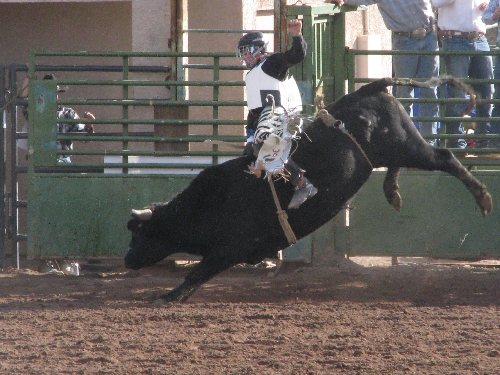High school students across Nevada saddle up for rodeo competitions
Every December for 10 days Las Vegas embraces the rodeo lifestyle when the National Finals Rodeo comes to town. But for some local teens, rodeo is their life every day of every month.
The Wrangler National Finals Rodeo is the culminating event for the 120 professional cowboys and 15 professional barrel racers who qualify. Composed of bareback riding, steer wrestling, team roping, saddle bronc riding, tie-down roping, barrel racing and bull riding, this is the Super Bowl of rodeo.
Rodeo is different from most other sports in that all rodeo contestants depend on animals for their success. For the barrel racers and pole benders, it is the horse they ride. For the saddle and bareback riders, it is the bucking horse they must stay on for 8 seconds. For the ropers, it is a combination of their horse and the steer or calf they draw. For the bull riders, it is the bucking bull beneath them. Rodeo is not an individual sport.
Rodeo also is a sport that requires natural talent and a lifetime of experience.
"You cannot just go pick up a bull rope and ride a bull," says Clay Hendrix, president of the Nevada High School Rodeo Association.
The sport requires guts, goals and plenty of practice. Nevada High School Rodeo Association student president Cydney Bryan, a senior at Palo Verde High School, says she practices every day. This also is true for most contestants competing at the high school level.
"We work very hard in the practice pen to make our rodeo runs count," says Shawnee Ennis, contestant, student public relations director and junior at Silver State Charter School.
Despite practicing, heartbreak still comes to contestants.
"Every one-thousandth of a second counts," Ennis says. "Because that could be the difference between first and second place and the difference between 10 points and nine points."
Rodeo, however, is more than a sport; it is a separate world, according to Bryan.
The rodeo world, prevalent in Las Vegas, has different divisions from those at the NFR. Still, most of the pros got their start in High School Rodeo, a national organization.
Begun in the 1940s, the National High School Rodeo Association now has associations in 46 states and provinces. Every year, the best of the best from each participating state or province converge in Farmington, N.M., for the National High School Rodeo Finals.
High school rodeo simply means that the contestants are in high school. It is not affiliated with one school. Teams are assigned geographically. Southern Nevada has clubs in Alamo, Boulder City, Moapa, Las Vegas, Lincoln County, Pahrump and Virgin Valley.
High school rodeo is open to all high school students including public, private and home-schooled, according to Hendrix.
Furthermore, in order to compete in these rodeos, contestants must meet the grade requirements of the Nevada Interscholastic Athletic Association and must be in good standing with their school. Compared to other high school sports, contestants are more involved in the overall production and management of the rodeos.
"Rodeo is the only sport that allows us to be involved in everything that goes on in the association," Ennis says. "We decide what prizes we give, what kind of fundraisers we do, whether we are going to have a dance, a team roping or a barrel race after the rodeo. We choose our directors to represent us, and we vote for officers on the club, state and national levels."
At each rodeo, contestants double as the event directors who make sure everything runs smoothly.
At the state level, the contestants are represented by student president Bryan, who has been involved with rodeo for 10 years and still loves it.
"It's so much fun, exciting, huge adrenaline rush, and (rodeo) teaches you life lessons," Bryan says.
Rodeo mom Jill Combs also knows the power of rodeo.
"It taught (my son) a lot of responsibility and time management," she says.
In order to qualify for nationals, a contestant must compete in at least three rodeos. The Nevada High School Rodeo Association's season consists of 27 rodeos throughout the state.
In June, the most recent National Finals proved successful for the Nevada team.
The top four in each event from the State Finals represented Nevada and finished fifth in the team standings.
Rachel Primm was named the national champion in barrel racing, and Joe Harper was the national champion in the saddle bronc. Shelby Scott took sixth place in breakaway roping, seventh in goat tying and fifth in the all-around. Trenton Montero placed in a three-way tie for ninth in bareback riding. In cutting, Casey Barton placed ninth in the boys division and DeeAnna Pasquale placed ninth in the girls division.
To the contestants, the National Finals in high school rodeo is equivalent to college football's Bowl Championship Series game. However, it is not the end of the road for seniors. Like their high school counterparts who run, throw and swim, these teens have their eyes on college and lucrative scholarships, and they hope their rodeo skills will land them a spot on a college rodeo and/or equestrian team.
The University of Nevada, Las Vegas has both a men's and women's college rodeo team.
"The winningest team at UNLV is the rodeo team," says Clark County Commissioner Tom Collins, a cowboy who competed in his first high school rodeo in 1965. Las Vegas old-timers might remember when there was an arena at a spot now known as Lorenzi Park. Today, Collins continues to be an advocate for rodeo in Nevada.
The 2010-11 high school rodeo season is well under way. More than 100 contestants from across the West will be featured today at the Las Vegas High School Rodeo at Horseman's Park, 5800 E. Flamingo Road. For more information on the Nevada High School Rodeo Association, visit nshsra.net.
R-Jeneration


















